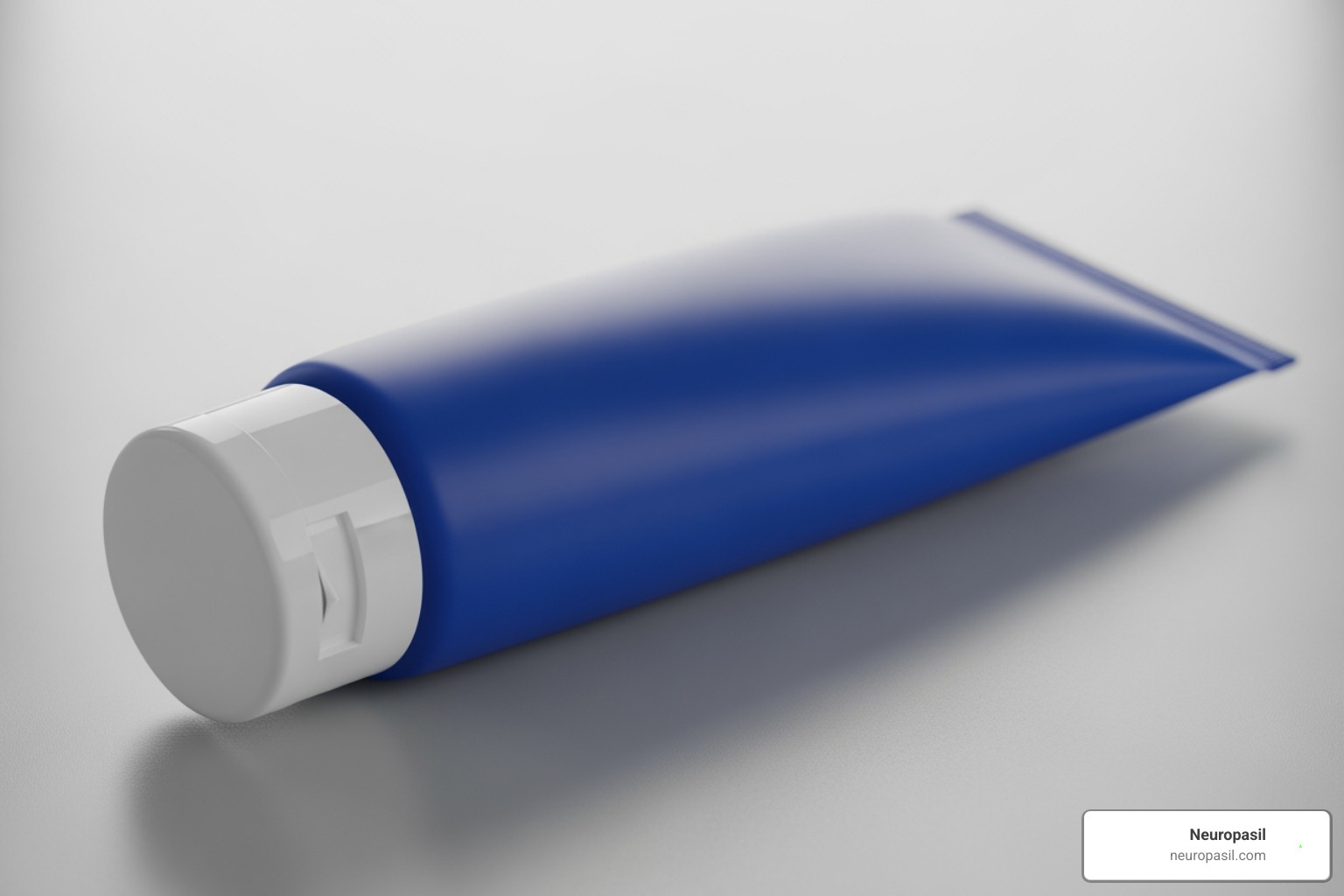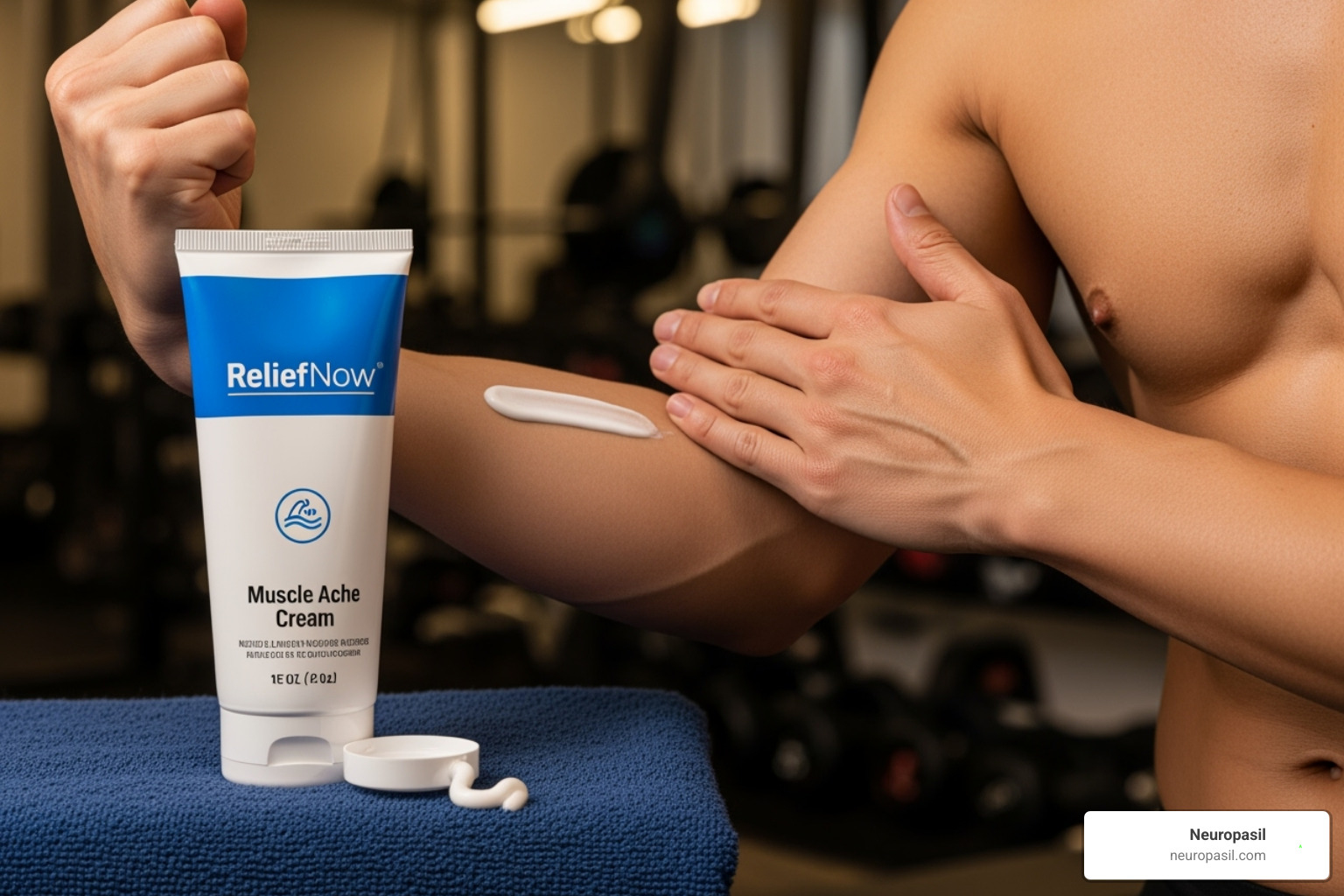Why Muscle Ache Cream is Your First Line of Defense Against Pain

Muscle ache cream offers targeted relief right where you need it. Unlike oral medications that affect your entire system, these topical solutions deliver active ingredients directly through your skin to reduce pain signals and provide comfort with fewer side effects.
Quick Answer for Muscle Ache Cream Relief:
- Fast-acting relief: Works within 5-20 minutes of application.
- Common ingredients: Menthol (cooling), camphor (warming), arnica (anti-inflammatory).
- Application: Apply 3-4 times daily to affected areas.
- Forms available: Creams, gels, roll-ons, sprays, and patches.
- Best for: Muscle soreness, joint pain, strains, and everyday aches.
Whether it's post-workout soreness or chronic neck tension, the right topical pain reliever can make a huge difference. Research shows over-the-counter muscle rubs are highly effective for localized pain. As one certified personal trainer noted, "I've found that spending at least a minute massaging it in can help the formula absorb into the skin more quickly (and it feels great on achy muscles)."
With so many options, from cooling menthol to warming capsaicin, choosing can be tough. This guide will help you understand how these creams work and what ingredients to look for, so you can make an informed decision.

Understanding Muscle Ache Creams: How They Bring Relief
When you have an ache, you want relief that goes straight to the source. That's what muscle ache cream delivers. These topical analgesics apply active ingredients directly through your skin, targeting pain without the systemic effects of oral medications. This localized approach makes them an excellent over-the-counter solution.
The science behind these creams often involves the gate control theory of pain. In short, they create sensations (like cooling or warming) that compete with pain signals, effectively distracting your brain and closing the 'gate' that allows pain to be felt.
How Do They Work?
Muscle ache cream targets pain from multiple angles. Scientific research on topical analgesics shows these mechanisms provide effective relief without the side effects common to oral medications.
- Counter-irritation: Ingredients like menthol and camphor create cooling or warming sensations on the skin. This pleasant distraction gives your pain receptors something else to focus on, reducing your perception of the ache.
- Blocking Pain Signals: Some ingredients work directly on nerve endings, preventing pain messages from reaching your brain.
- Increasing Blood Flow: Improved circulation delivers more oxygen to muscles and helps carry away waste products that cause soreness, which reduces inflammation and promotes healing.
The Different Forms of Topical Pain Relief
Different forms offer unique advantages depending on your needs. Neuropasil offers convenient options to match your preferences.
- Creams: The classic choice. Their thick texture is ideal for massaging into muscles, which helps increase blood flow. They provide deep penetration but may leave a slight residue.
- Gels: Perfect for fast, non-greasy absorption. Gels are lighter than creams, making them great for daytime use when you don't want marks on clothing.
- Roll-ons: The ultimate in convenience. They offer a no-mess, targeted application with a gentle massaging effect from the roller ball, perfect for on-the-go relief.
The key is choosing a form you'll use consistently. The best muscle ache cream is the one you'll reach for whenever discomfort strikes.
The Anatomy of a Muscle Ache Cream: Key Active Ingredients
The secret to an effective muscle ache cream lies in its active ingredients. Understanding what's inside your topical pain reliever helps you choose the best product for your needs.

Counterirritants: The Power of Sensation
Counterirritants create sensations that distract your brain from pain.
- Menthol: Derived from peppermint, it provides a refreshing cooling sensation by stimulating cold receptors. This effect helps your brain pay less attention to pain signals. How menthol works on the body's pain signals is well-documented, and Neuropasil formulas use balanced concentrations for optimal relief.
- Camphor: Delivers a soothing warming sensation to stiff muscles. It also acts as a mild pain reliever, helping reduce discomfort and swelling.
- Methyl Salicylate: Also known as wintergreen oil, this ingredient provides warmth and is chemically related to aspirin, helping to reduce inflammation.
Soothing and Comforting Ingredients
These natural botanicals and extracts support your body’s healing processes.
- Arnica: This flower extract is effective for reducing inflammation, swelling, and bruising. Effectiveness of topical Arnica research shows it's especially helpful for joint discomfort in areas like the fingers and wrists.
- Herbal Extracts: Many formulas include ingredients like emu oil, MSM (methylsulfonylmethane), boswellia, and myrrh for their anti-inflammatory and joint-supporting properties.
Natural Innovators: Capsaicin and CBD
These ingredients offer unique approaches to pain relief.
- Capsaicin: Derived from chili peppers, it creates a warming sensation and depletes Substance P, a neurotransmitter that sends pain signals to the brain. Regular use can reduce the perception of chronic pain.
- CBD (Cannabidiol): This non-psychoactive compound has noted anti-inflammatory benefits of CBD. It interacts with the body's endocannabinoid system to help regulate pain and inflammation.
Neuropasil's formulas combine these ingredients to create comprehensive solutions for muscle and nerve discomfort. By blending immediate-relief counterirritants with healing botanicals and natural innovators, these products address pain from multiple angles.
Choosing Your Ideal Muscle Ache Cream: A Buyer's Guide
Selecting the perfect muscle ache cream is easier when you know what to look for. By matching the product to your needs, you can find a formula that truly works.

Matching the Formula to Your Discomfort Type
Different types of pain respond best to different ingredients.
- Post-Workout Soreness: Cooling menthol creams or gels provide immediate, soothing relief for overworked muscles.
- Joint Discomfort: For issues like arthritis, look for anti-inflammatory ingredients like arnica that target the underlying cause. You can find more information on joint health from trusted sources.
- Sprains and Strains: A combination approach works well. Start with cooling formulas to reduce swelling, then switch to warming ones to promote blood flow and healing.
- Chronic Stiffness: Persistent tension often responds well to warming creams that relax tight muscles. CBD-infused formulas can also offer sustained relief.
- Nerve Discomfort: This requires specialized ingredients. Neuropasil’s targeted formulas are designed to address these unique needs.
Finding the Right Application Method for You
The application method can impact how well a product fits your lifestyle.
- Creams: Excellent for massaging into large areas. The hands-on application can be therapeutic, but you'll need to wash your hands afterward.
- Gels: Absorb quickly with a light, non-greasy feel. They are ideal for fast relief without any fuss or residue on clothing.
- Roll-ons: Incredibly convenient for on-the-go use. They provide a no-mess, targeted application with a gentle massaging effect.
Personal Preferences: Scent, Sensation, and Skin Sensitivity
The best muscle ache cream is one you'll use regularly.
- Scent: Many products have a strong menthol or camphor smell. If you're sensitive, look for fragrance-free options or those with subtle, natural aromas.
- Sensation: Decide if you prefer an invigorating cooling blast or a cozy warming heat. Cooling is great for acute pain, while warming is often better for chronic stiffness.
- Skin Sensitivity: If you have sensitive skin, always perform a patch test first. Look for formulas designed for sensitive skin and avoid known irritants like artificial dyes or parabens.
Neuropasil's range of targeted formulas considers these preferences, offering options that address both your pain and comfort.
Safety First: Precautions and When to See a Doctor
While muscle ache cream is a trusted tool for pain relief, it's crucial to use it safely and know when to see a doctor. Topical pain relievers are generally safe when used correctly, but they require attention.

How to Use Your Muscle Ache Cream Safely
The most common side effect is skin irritation, such as redness, itching, or a burning sensation. To use your cream safely and avoid issues:
- Perform a patch test: Before full use, apply a small amount to your inner forearm and wait at least an hour to check for irritation.
- Never apply to broken skin: Avoid open wounds, cuts, or irritated areas to prevent ingredients from entering your bloodstream directly.
- Wash your hands thoroughly: Always wash your hands after application to avoid accidentally getting the cream in your eyes or on other sensitive areas.
- Avoid heating pads: Do not use heating pads or tight bandages over an area where you've applied a warming cream, as this can cause burns.
- Follow directions: Most creams are for use 3-4 times daily. Overuse can increase the risk of side effects without adding benefits.
- Watch for allergic reactions: Though rare, if you experience hives, swelling, or difficulty breathing, stop use and seek immediate medical attention.
Red Flags: When to Consult a Healthcare Professional
Topical relievers are for minor discomfort. See a doctor if you experience any of the following:
- Discomfort lasts more than 7 days despite consistent use.
- Severe discomfort that interferes with your daily activities.
- Symptoms are worsening instead of improving.
- Signs of infection, such as heat, significant swelling, redness, or pus.
- Numbness or tingling, which can signal nerve involvement.
- Discomfort is accompanied by fever or other systemic symptoms.
- Pain is from a significant injury, like a fall or accident.
- You have pre-existing health conditions or take other medications, especially blood thinners.
Seeking professional help is a smart step toward identifying the root cause of your pain and finding the most effective treatment plan.
Frequently Asked Questions about Muscle Ache Creams
Here are answers to some of the most common questions about muscle ache cream.
How long does it take for a muscle ache cream to work?
The time it takes to feel relief depends on the ingredients in your muscle ache cream.
- Immediate Sensation: Counterirritants like menthol and camphor provide a cooling or warming feeling within minutes.
- Deeper Relief: Ingredients that block pain signals or reduce inflammation typically take 20 to 30 minutes to take full effect.
- Herbal Ingredients: Natural ingredients like arnica may work more gradually as they absorb and target inflammation.
Can I use a muscle ache cream every day?
Yes, for most over-the-counter products, daily use is fine if you follow the package directions.
- Frequency: The standard recommendation is no more than 3 to 4 times in a 24-hour period.
- Duration: For acute injuries, many products recommend not using them for more than 7 consecutive days without consulting a doctor.
- Chronic Conditions: If you have a chronic condition, speak with your doctor about incorporating a topical cream into your long-term pain management plan.
Can I use more than one type of pain relief product at the same time?
It's always best to consult your pharmacist or doctor before combining pain relief products.
- Topical + Topical: Using different creams on the same spot can cause skin irritation. If you use different types, allow time for the first to absorb before applying another.
- Topical + Oral: This can be risky. For example, combining a topical NSAID cream with an oral NSAID like ibuprofen increases the risk of side effects. Always check with a healthcare professional before mixing medications.
Conclusion: Your Next Step Towards Muscle Discomfort Relief
Finding the right muscle ache cream is about understanding your options and matching them to your needs. As we've covered, these topical treatments work by delivering targeted ingredients like cooling menthol, warming camphor, and anti-inflammatory arnica directly to the source of your pain.
The key is to match the formula to your specific discomfort—whether it's post-workout soreness, chronic stiffness, or joint pain. Choosing an application method you like, such as a massaging cream, a fast-absorbing gel, or a convenient roll-on, ensures you'll use it consistently.
Most importantly, always prioritize safety by following product directions and recognizing when it's time to see a doctor for persistent or severe pain. Taking control of muscle discomfort allows you to get back to living fully.
For a specialized approach to muscle and nerve discomfort, explore Neuropasil's targeted relief formulas with a limited-time 25% discount and free shipping.













